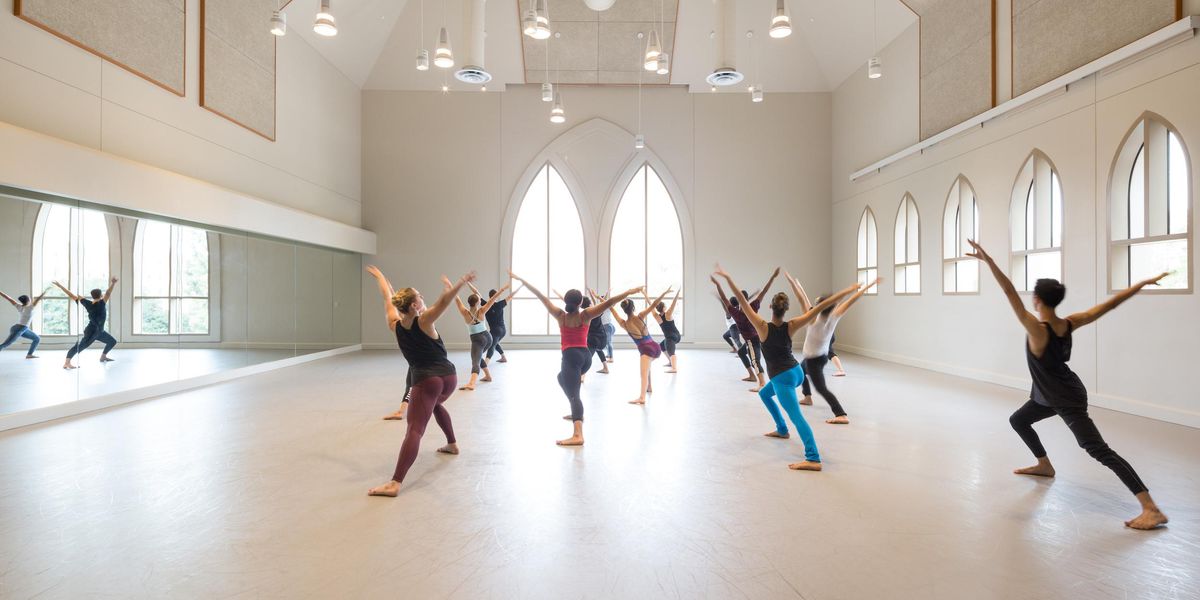I Couldn’t Help Doing the Merengue at ACDFA
Last Saturday morning Pam Plagge was teaching a class in Latin dance to about 80 students in the Great Hall of the University of Wisconsin—Madison as part of the North Central Regional Conference of ACDFA. I was there to chair a panel on Dancing in Higher Education, but when I wasn’t’ doing that, I was class hopping. And for this particular class, I was the lone observer, pretty much out of sight. So when Plagges turned on the boombox and started treading with hips super-relaxed, and all those college kids fell into the groove, I just couldn’t resist. I learned that the Merengue is very much like the treading in Trisha Brown’s “Spanish Dance,” which I had done many times when I was in her company in the 1970s. You just tread with your feet and fell the weight—and sexiness—of your hips swaying as you go.
I peeked in on some other fabulous classes too. Chris Walker, who teaches African dance at University of Wisconsin—Madison, is a gorgeous dancer—fluid like a river in his undulations. With two drummers, he got about 120 students going. At one point, he had them do a little stiff-legged stepping, kind of like a pas de bourrée but front to back, not side to side, and kind of like a Yemenite in folk dancing. To the stiff legs he added “puppet arms,” hiking them up by the elbows. Again, I just couldn’t resist trying it out. Another time, while bent over in something like downward dog, he had them knock their knees together and out.
Li Chiao-Ping, also on the faculty of UW—Madison, taught a modern class where she had people moving across the floor low-to-the-ground, using the arms like a capoeirista. They coiled in before shooting the legs out and twisting back the other way—sort of a sideways crunched up jackknife dive (“gather your energy in and explode out”).
I caught the warmup of a hip hop class taught by Kaspar, a former “So You Think You Can Dance” contestant from Chicago. The aerobic half hour of non-stop going to the beat was energized with a spring in his step—almost lifting off into the air on each step—that most students didn’’t quite catch. At one point he had them shifting weight from side to side while also knocking the knees in—yes, just like in the African dance class.
I saw great new ways of using partners in class. Luc Vanier, from University of Wisconsin—Milwaukee, teamed up with Rebecca Nettl-Fiol , from the University of Illinois at Urbana/Champaign, to apply principles of child development to dance. While one person spiraled on the floor, the other person snapped her fingers around her head so that the spiraler would lead with the senses. Then, standing up, Vanier demonstrated how that spiral helps create a fluid pirouette.
In Carl Flink’s class, one student jumped backward while another interrupted his jump and pushed him from behind. Flink showed how, using the surface of the other person’s back, you could look like you’re pushing aggressively but really you’re being supportive and working as a team. Flink (“Find your inner Spiderman”) has a straightforward manner and athletic approach that appeals to the guys as well as girls. In my panel later that day, he said he has quadrupled the number of men dance majors at University of Minnesota—Minneapolis since he started the men’s class four or five years ago.
Jan Erkert, head of the dance department at University of Illinois at Urbana/Champaign, taught a class with exquisite attention to the body, giving students the choice of using energy on a 1-10 basis. To start the class, her accompanist launched into a bewitching rendition of “My Funny Valentine,” walking among the dancers. This impromptu performance prompted Erkert to tell the students, “Think of walking as a beautiful song.”
The teachers on panel on Dancing in Higher Education were Carl Flink; Chris Johnson, chair of dance at Beloit; Alan Sener, chair of dance at University of Iowa at Iowa City (with 178 dance majors!); Pam McNeil and Richard Woodbury from Columbia College in Chicago. One of the first topics that came up was competition, both within ACDFA (get Elizabeth Zimmer’s take of ACDFA as a form of March Madness in our March issue—page 76—) and colleges. Other topics were students’ preconceptions of dance programs, how to introduce dance to new students, and how to balance one’s artistic research with teaching responsibilities.
Though they had diverse approaches, all panelists agreed that liberal arts dance programs are training students to be full, whole people who may end up working in the dance field but not necessarily as professional dancers. They enjoy seeing the other parts of the student, knowing they are stimulated by their studies of other cultures and other areas.
One of the stories about how students can draw on other parts of themselves came from Chris Johnson of Beloit. She was working on a piece about the holocaust and invited a survivor of the concentration camps into her class and worked with other departments on the project. She talked about how much that meant to her students, who eventually performed the piece at the holocaust museum in Washington, DC.
Another story that stuck with me was that of Patti Carr, who teaches at Dickinson State University in North Dakota. On her campus, the drinking problem grew to tragic proportions when two students died from alcohol abuse. She found a way to address the problem through dance, working with the students and incorporating the issue into their performances. As a result some of the footballs players on campus have given up booze. How’s that for a concrete way that dance can address social ills?!
—Wendy Perron




